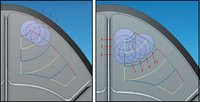Plunge milling along a pattern of arcs may offer an even better way for slower machines to mill pockets productively.
Plunge milling offers a way to mill deep pockets productively without the need for high speed machining. An older machining center may be slow, but as long as the machine is fairly rigid, it can potentially achieve a high metal removal rate by roughing out material in a series of overlapping plunges with a long tool. These plunges are straight Z-axis moves into the work, similar to drilling moves. Certain milling cutters are designed to be effective at cutting this way, and according to CAD/CAM developer Delcam, a certain pattern of plunges is also more effective for this kind of cutting.
Delcam explained its ideas about plunge milling as part of a conference related to aerospace machining that the company recently held in Paris, France. In plunge milling, the company says, few give thought to the tool path. Most users tend to assume that straight, parallel rows of plunges are sufficient.
This "raster" pattern of plunging proceeds as follows: After an initial hole is machined (perhaps by drilling), the first milling plunge overlaps with this hole. (Every plunge has to overlap with open space so that chips can escape.) The second plunge then overlaps with the first, and so on—in a straight row of plunges that runs the length of the pocket. After the first such row is done, the tool steps over to do a second row that overlaps with the first row, and so on.
That approach creates problems for the first row, Delcam says. The "slot" machined in this way leaves little clearance for chips to escape, so chip compaction is likely. Also, every plunge along this row overlaps with nothing but the preceding plunge, so material engagement tends to be high.
Another problem is that a series of straight rows may not be a good fit for the shape of the pocket. This is particularly true of the many odd-shaped pockets typical of aircraft parts. If the pattern of plunges can’t conform to the pocket’s shape, then "upstands" of remaining material may be left around the pocket’s edge.
The company says a better approach is to let sequential plunges follow a pattern of circular arcs. An initial hole is still the starting point, and the first plunge overlaps with this. But then, the second plunge may overlap with both the first plunge and the initial hole, and so on—with the plunge following an arc that orbits around the initial hole. The second series of plunges then may follow a larger arc that orbits around this plunged-out area, and so on.
One clear advantage of the typical, straight-line pattern of plunging is ease of programming. Straight rows of plunges are easier for the software to generate. A more complex pattern such as an array of arcs has to be drawn by the programmer. The machining cycle following this pattern does have the potential to be both more productive and more effective, the company says, but programming does take a bit more time.
Wednesday, December 21, 2005
Plunge milling offer better productivity
Posted by
CNC-on-NET
at
9:46 AM
![]()
Subscribe to:
Post Comments (Atom)





No comments:
Post a Comment